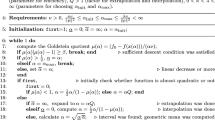Abstract
Given a tree each of whose terminal vertices is associated with a given point in a compact metric space, the problem is to optimally associate a point in this space to each nonterminal vertex of the tree. The optimality criterion is the minimization of the sum of the lengths, in the metric space, over all edges of the tree. This note shows how a dynamic programming solution to this problem generalizes a number of previously published algorithms in diverse metric spaces, each of which has direct and significant applications to biological systematics or evolutionary theory.
Similar content being viewed by others
References
L.L. Cavalli-Sforza and A.W.P. Edwards, “Phylogenetic analysis: models and estimation procedures”,American Journal of Human Genetics 19 (1967) 233–257.
J.S. Farris, “Methods for computing Wagner trees”,Systematic Zoology 19 (1970) 83–92.
W.M. Fitch, “Towards defining the course of evolution: minimum change for a specific tree topology”,Systematic Zoology 20 (1971) 406–416.
E.N. Gilbert and H.O. Pollak, “Steiner minimal trees”,SIAM Journal on Applied Mathematics 16 (1968) 1–29.
M. Hanan, “On Steiner's problem with rectilinear distance”,SIAM Journal on Applied Mathematics 14 (1966) 255–265.
J.A. Hartigan, “Minimum mutation fits to a given tree”,Biometrics 29 (1973) 53–65.
F.K. Hwang, “On Steiner minimal tree with rectilinear distance”, manuscript.
H.W. Kuhn, “A note on Fermat's problem”,Mathematical Programming 4 (1973) 98–107.
Z.A. Melzak, “On the problem of Steiner”,Canadian Mathematical Bulletin 4 (1961) 143–148.
Z.A. Melzak,Companion to concrete mathematics (Wiley, New York, 1973) Chapter 4, Section 3.
G.W. Moore, J. Barnabas and M. Goodman, “A method for constructing maximum parsimony ancestral amino acid sequences on a given network”,Journal of Theoretical Biology 38 (1973) 459–485.
D. Sankoff, “Minimal mutation trees of sequences”,SIAM Journal on Applied Mathematics 28 (1975) 35–42.
D. Sankoff, R.J. Cedergren and G. Lapalme, “Frequency of insertion-deletion, transversion and transition in the evolution of 5S ribosomal RNA”,Journal of Molecular Evolution, to appear.
D. Sankoff, C. Morel and R.J. Cedergren, “Evolution of 5S RNA and the non-randomness of base replacement”,Nature New Biology 245 (1973) 232–234.
P.H. Sellers, “An algorithm for the distance between two sequences”,Journal of Combinatorial Theory 16 (1974) 253–258.
S.M. Ulam, “Some combinatorial problems studied experimentally on computing machines”, in: S.K. Zaremba, ed.,Applications of number theory to numerical analysis (Academic Press, New York, 1973) pp. 1–10.
R.A. Wagner and M.J. Fischer, “The string-to-string correction problem”,Journal of the Association for Computing Machinery 21 (1974) 168–173.
Author information
Authors and Affiliations
Rights and permissions
About this article
Cite this article
Sankoff, D., Rousseau, P. Locating the vertices of a steiner tree in an arbitrary metric space. Mathematical Programming 9, 240–246 (1975). https://doi.org/10.1007/BF01681346
Received:
Revised:
Issue Date:
DOI: https://doi.org/10.1007/BF01681346




